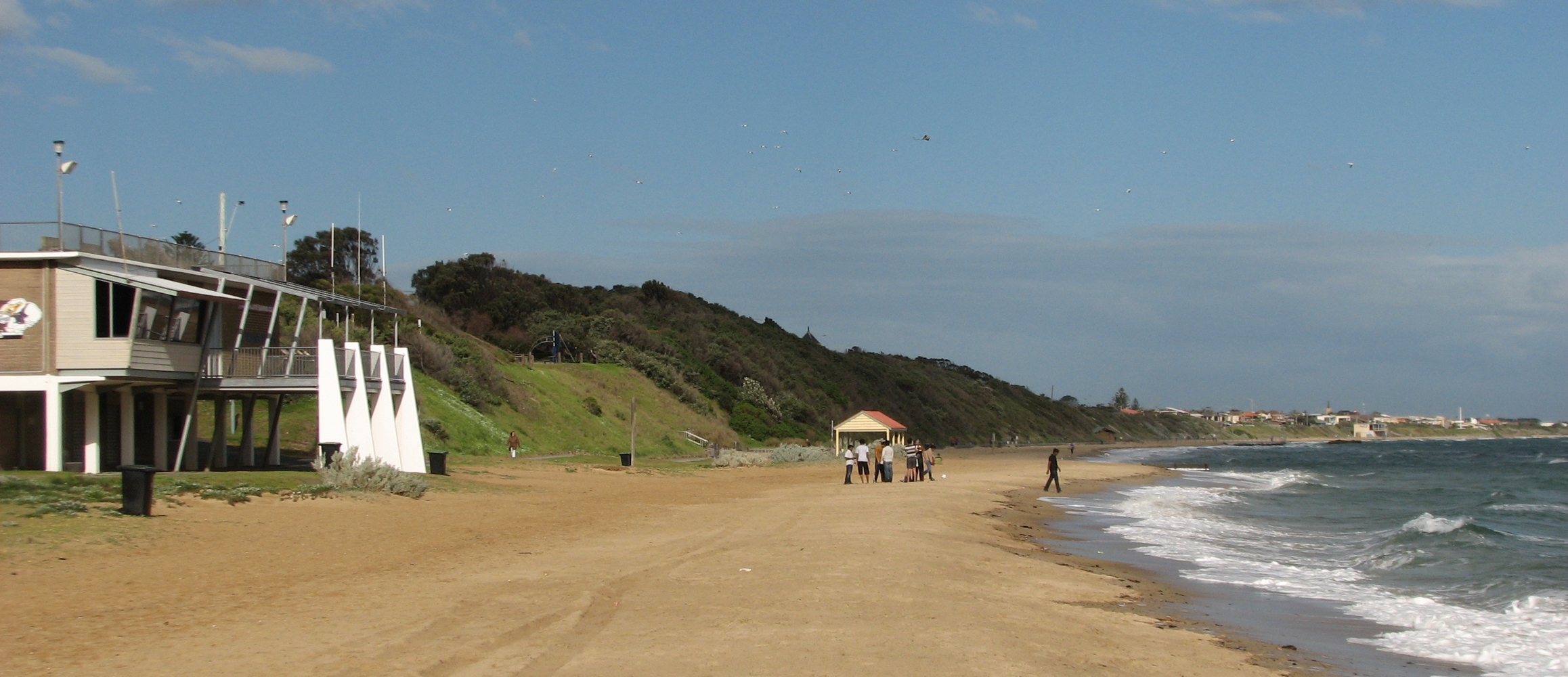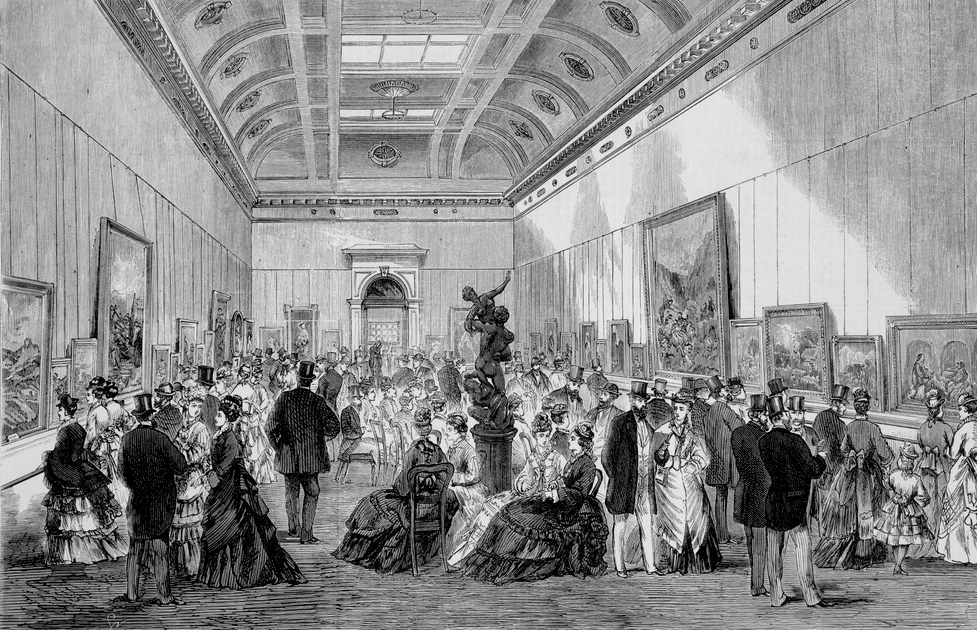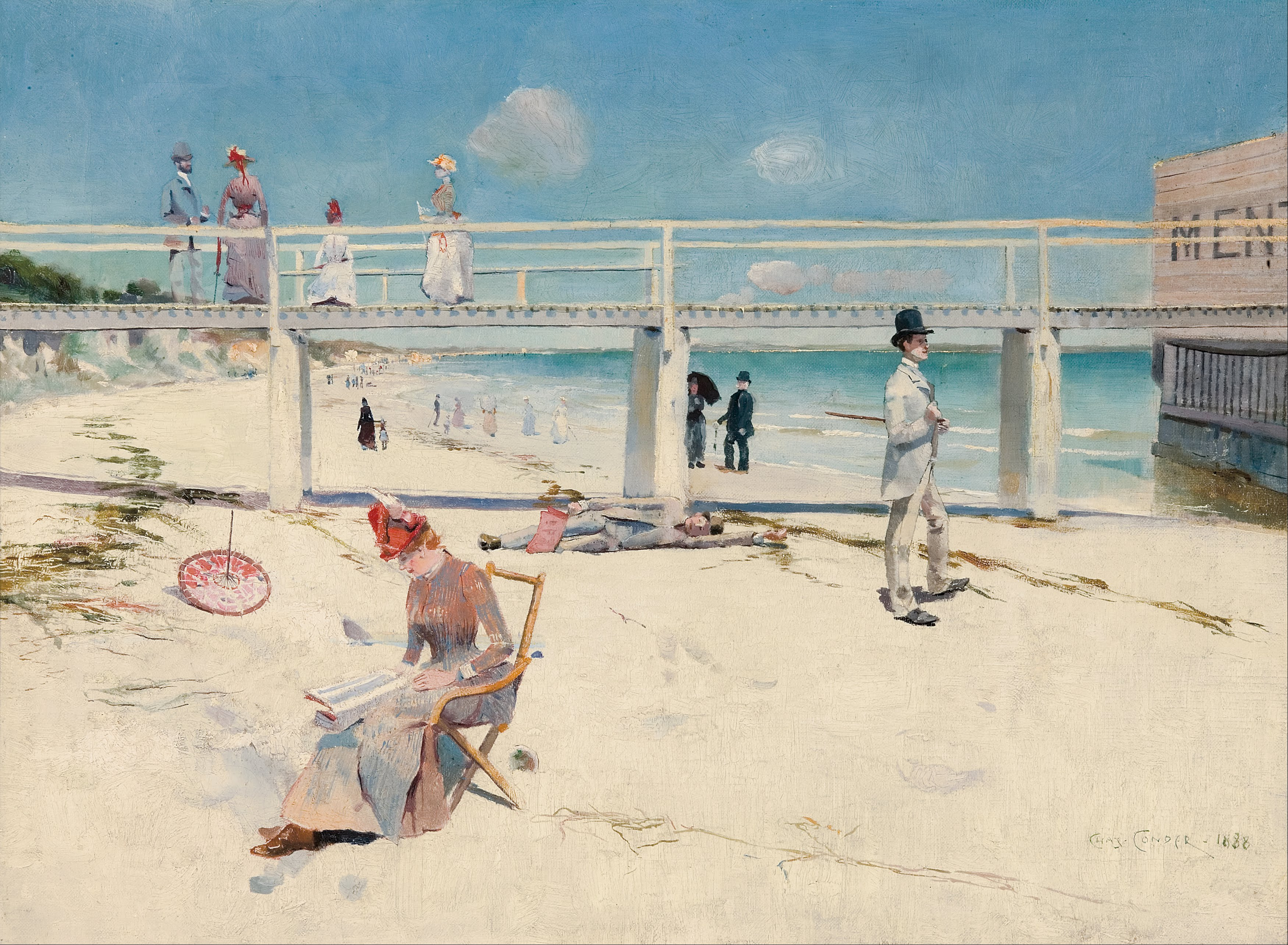|
Mentone, Victoria
Mentone is a suburb in Melbourne, Victoria, Australia, 21 km south-east of Melbourne's Central Business District, located within the City of Kingston local government area. Mentone recorded a population of 13,197 at the . It is known locally for Mentone Beach, which extends alongside Beaumaris Bay from the cliffs in Beaumaris and ends at Warrigal Road where it meets Parkdale. Mentone is associated with the Heidelberg School of Australian artists. History File:Charles Conder - A holiday at Mentone - Google Art Project.jpg, '' A holiday at Mentone'', 1888, oil on canvas by Charles Conder. File:Tom Roberts - Slumbering sea, Mentone - Google Art Project.jpg, Tom Roberts, ''Slumbering Sea, Mentone'' (1887) National Gallery of Victoria File:Tom Roberts - Mentone, 1889.jpg, Tom Roberts, ''Mentone'', (1889), National Gallery of Victoria. File:Mentone Beach 1, Mentone, Vic, jjron, 08.01.2014.jpg, View over Mentone Beach and Beaumaris Bay south towards Mordialloc and Frank ... [...More Info...] [...Related Items...] OR: [Wikipedia] [Google] [Baidu] |
Mentone Beach
Mentone Beach is a beach located in Mentone, on Port Phillip Bay, Victoria, Australia, 21 kilometres south from the Melbourne City Centre. Mentone beach is the northern section of a beach that extends alongside Beaumaris Bay from the cliffs at Rickett's Point in Beaumaris to Frankston in the south on the eastern shoreline of Port Phillip Bay. Mentone Beach is one of the Port Phillip Bay beaches associated with the Heidelberg School of Australian artists. Geology Mentone Beach was formed when Port Phillip sunklands in southern Victoria were inundated to form Port Phillip Bay. The inundation was triggered in part by the Selwyn Fault on the east and the Rowsley Fault on the west side of the bay. The Beaumaris Monocline is a geological feature which is expressed in the cliffs near Beaumaris and Rickett's Point at the northern end of Mentone Beach. This structure controls the coastal indentation, and therefore the Mentone and Mordialloc beaches, which lie due south of Rickett's Po ... [...More Info...] [...Related Items...] OR: [Wikipedia] [Google] [Baidu] |
Australia
Australia, officially the Commonwealth of Australia, is a country comprising mainland Australia, the mainland of the Australia (continent), Australian continent, the island of Tasmania and list of islands of Australia, numerous smaller islands. It has a total area of , making it the list of countries and dependencies by area, sixth-largest country in the world and the largest in Oceania. Australia is the world's flattest and driest inhabited continent. It is a megadiverse countries, megadiverse country, and its size gives it a wide variety of landscapes and Climate of Australia, climates including deserts of Australia, deserts in the Outback, interior and forests of Australia, tropical rainforests along the Eastern states of Australia, coast. The ancestors of Aboriginal Australians began arriving from south-east Asia 50,000 to 65,000 years ago, during the Last Glacial Period, last glacial period. By the time of British settlement, Aboriginal Australians spoke 250 distinct l ... [...More Info...] [...Related Items...] OR: [Wikipedia] [Google] [Baidu] |
National Gallery Of Victoria
The National Gallery of Victoria, popularly known as the NGV, is an art museum in Melbourne, Victoria (state), Victoria, Australia. Founded in 1861, it is Australia's oldest and list of most visited art museums in the world, most visited art museum. The NGV houses its collection across two sites: NGV International, located on St Kilda Road in the Melbourne Arts Precinct of Southbank, Victoria, Southbank, and the Ian Potter Centre: NGV Australia, located nearby at Federation Square. The NGV International building, designed by Sir Roy Grounds, opened in 1968, and was redeveloped by Mario Bellini before reopening in 2003. It houses the gallery's international art collection and is on the Victorian Heritage Register. The Ian Potter Centre: NGV Australia, designed by Lab Architecture Studio, opened in 2002 and houses the gallery's Australian art collection. A third site, The Fox: NGV Contemporary, is planned to open in the Melbourne Arts Precinct in 2028, and will be Australia's lar ... [...More Info...] [...Related Items...] OR: [Wikipedia] [Google] [Baidu] |
Tom Roberts
Thomas William Roberts (8 March 185614 September 1931) was an English-born Australian artist and a key member of the Heidelberg School art movement, also known as Australian impressionism. After studying in Melbourne, he travelled to Europe in 1881 to further his training, and returned home in 1885, "primed with whatever was the latest in art". That year, he joined Frederick McCubbin in founding the Box Hill artists' camp, the first of several ''en plein air, plein air'' camps frequented by members of the Heidelberg School. Together with Arthur Streeton and Charles Conder, they staged the 1889 9 by 5 Impression Exhibition, Australia's first self-consciously avant-garde art exhibition. Nicknamed "Bulldog" due to his tenacity and drive, Roberts was considered the primary force behind the Heidelberg School movement. He encouraged other artists to capture the national life of Australia, and while he is best known today for his "national narratives"—among them ''Shearing the Rams ... [...More Info...] [...Related Items...] OR: [Wikipedia] [Google] [Baidu] |
Charles Conder
Charles Edward Conder (24 October 1868 – 9 February 1909) was an English-born painter, lithographer and designer. He emigrated to Australia and was a key figure in the Heidelberg School, arguably the beginning of a distinctively Australian tradition in Western art. Biography Birth and early years Conder was born in Tottenham, Middlesex, the second son, of six children, of James Conder, civil engineer and Mary Ann Ayres. He spent several years as a young child in India until the death of his mother (aged 31 years) on 14 May 1873 in Bombay, when Charles was four; he was then sent back to England and attended a number of schools including a boarding school at Eastbourne, which he attended from 1877. He left school at 15, and his very religious, non-artistic father, against Charles's natural artistic inclinations, decided that he should follow in his footsteps as a civil engineer. Australia In 1884, at the age of 16, he was sent to Sydney, Australia, where he worked for his ... [...More Info...] [...Related Items...] OR: [Wikipedia] [Google] [Baidu] |
A Holiday At Mentone
''A holiday at Mentone'' is an 1888 painting by Charles Conder, a leading member of the Heidelberg School movement, also known as Australian impressionism. It depicts people engaged in seaside activities on a sunny day at Mentone Beach, in the Melbourne suburb of Mentone. The painting is celebrated for capturing the heat and brilliant noonday sunshine that is characteristic of Australia. Noted also for its jokes and visual puns, ''A holiday at Mentone'' has been described as "a witty comment on the transformation of nature into artifice through fashion, decorum, and painting". Background In October 1888, Conder, aged 20, moved to Melbourne from Sydney. Conder had met the Melbourne-based painter Tom Roberts in Sydney the previous year and again at Easter 1888, where the pair had painted ''en plein air'' together at Coogee Beach. In Melbourne, Conder initially based himself at Roberts' Grosvenor Chambers studio and ''A Holiday at Mentone'' was his first painting in the new city, ... [...More Info...] [...Related Items...] OR: [Wikipedia] [Google] [Baidu] |
Heidelberg School
The Heidelberg School was an Australian art movement of the late 19th century. It has been described as Australian impressionism. Melbourne art critic Sidney Dickinson coined the term in an 1891 review of works by Arthur Streeton and Walter Withers, two local artists who painted ''en plein air'' in Heidelberg on the city's rural outskirts. The term has since evolved to cover these and other painters—most notably Tom Roberts, Charles Conder and Frederick McCubbin—who worked together at "artists' camps" around Melbourne and Sydney in the 1880s and 1890s. Drawing on naturalist and impressionist ideas, they sought to capture Australian life, the bush, and the harsh sunlight that typifies the country. The movement emerged at a time of strong nationalist sentiment in the Australian colonies, then on the cusp of federating. The artists' paintings, like the bush poems of the contemporaneous Bulletin School, were celebrated for being distinctly Australian in character, and ... [...More Info...] [...Related Items...] OR: [Wikipedia] [Google] [Baidu] |
Warrigal Road
Warrigal Road is a major inner urban road in southeastern Melbourne, Australia. On weekdays, it is heavily trafficked as it runs through many major suburbs along its route, traversing some of Melbourne's eastern and south-eastern suburbs. These suburbs include Chadstone, Oakleigh, and Cheltenham. The Chadstone Shopping Centre can be accessed directly from Warrigal Road at its eastern entrance. Route Warrigal Road begins at the intersection with Canterbury Road in Surrey Hills and runs south as a four-lane, single-carriageway road with a speed limit at 60 km/h, up and down steep gradients, through the intersection with Toorak Road and Burwood Highway at Burwood (where the highway declaration starts) and continues south to the intersection with High Street Road at Ashwood, where the road widens to a six-lane, dual-carriageway road with bus lanes. Continuing south, it crosses under the Glen Waverley railway line (where the bus lanes end) and the Monash Freeway in Chadston ... [...More Info...] [...Related Items...] OR: [Wikipedia] [Google] [Baidu] |
Beaumaris Bay
Beaumaris Bay ( ) is a short but wide bay within the eastern shore of Port Phillip Bay in southern Victoria, Australia. It commences at the cliffs of Rickett's Point in the southern end of the Melbourne suburb of Beaumaris, then recesses north briefly alongside Mentone Beach in Mentone before stretching south through a string of suburban beaches along Parkdale, Mordialloc, Aspendale, Edithvale, Bonbeach, Carrum and Seaford, and ends at a small headland near the Olivers Hill boat ramp at the junction between Frankston and Mount Eliza. The main tributary streams draining into the bay are Mordialloc Creek, Patterson River, Kananook Creek and Sweetwater Creek. The bay is an important site for the beachgoing, recreational fishing, boating and water sport culture of Melbourne due to its long stretches of fine beachfront, the numerous piers, jetties, boat ramps, marinas and boat clubs along the coast, the proximity to some of the affluent, densely populated suburbs, the ... [...More Info...] [...Related Items...] OR: [Wikipedia] [Google] [Baidu] |
City Of Kingston
The City of Kingston is a local government area in Victoria, Australia in the south-eastern suburbs of Melbourne, its northern boundary lying approximately 15 km from the Melbourne city centre along the north-eastern shorelines of Port Phillip. It covers an area of 91 km² and has an estimated population of 163,431 people. History The City of Kingston area was originally governed by the Moorabbin Roads Board, which formed in 1862 and became a shire council in 1871, covering a large area of mixed agricultural and semi-urban land. After years of agitation, in 1917 the seaside town of Sandringham became a borough with its own council, and this fuelled the desire of those living in towns further south to combine their efforts and demand self-representation. This finally occurred in May 1920 and the "Borough of Mordialloc and Mentone" was formed. It became a town in 1923 and the City of Mordialloc in 1926. The City of Moorabbin had a population of 109,588 by the time ... [...More Info...] [...Related Items...] OR: [Wikipedia] [Google] [Baidu] |
Victoria (Australia)
Victoria, commonly abbreviated as Vic, is a States and territories of Australia, state in southeastern Australia. It is the second-smallest state (after Tasmania), with a land area of ; the second-most-populated state (after New South Wales), with a population of over 7 million; and the most densely populated state in Australia (30.6 per km2). Victoria's economy is the List of Australian states and territories by gross state product, second-largest among Australian states and is highly diversified, with service sectors predominating. Victoria is bordered by New South Wales to the north and South Australia to the west and is bounded by the Bass Strait to the south (with the exception of a small land border with Tasmania located along Boundary Islet), the Southern Ocean to the southwest, and the Tasman Sea (a marginal sea of the South Pacific Ocean) to the southeast. The state encompasses a range of climates and geographical features from its temperate climate, temperate coa ... [...More Info...] [...Related Items...] OR: [Wikipedia] [Google] [Baidu] |







